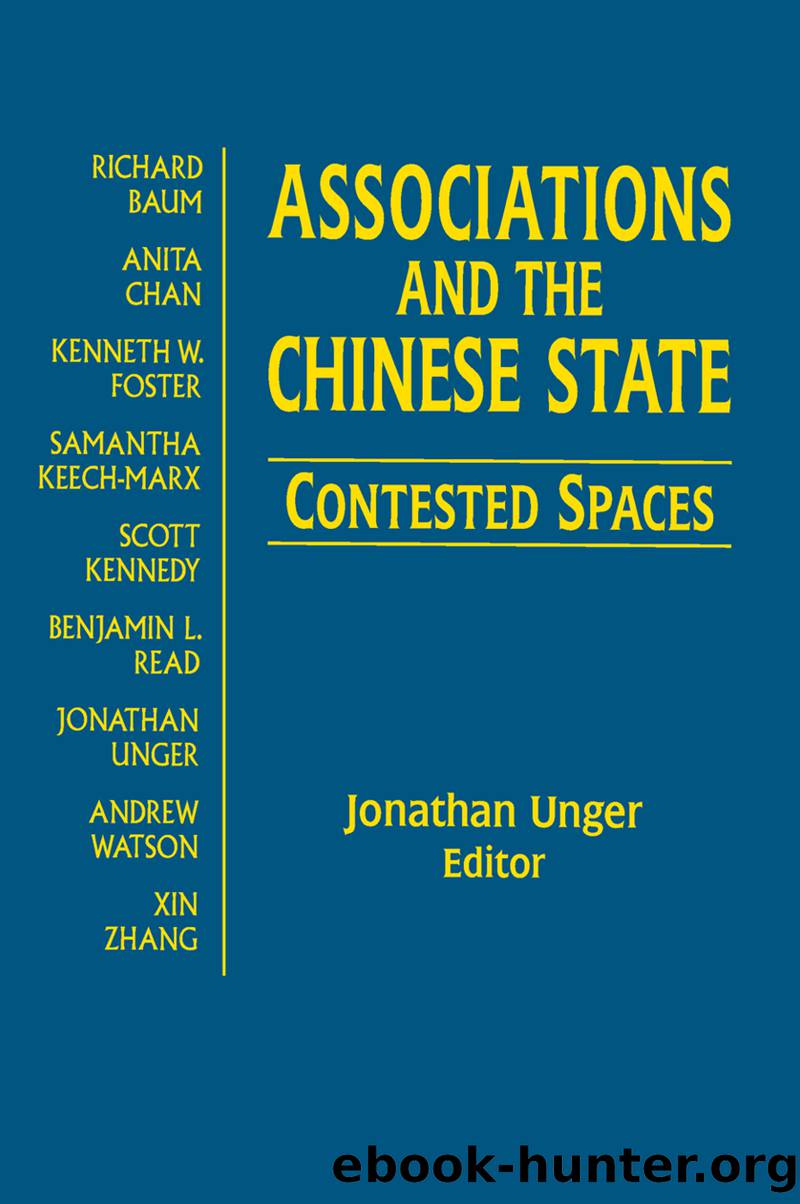Associations and the Chinese State: Contested Spaces by Unger Jonathan;

Author:Unger, Jonathan;
Language: eng
Format: epub
Publisher: Taylor & Francis Group
Published: 2015-08-15T00:00:00+00:00
The Federation of Industry & Commerce
In Beijing an important distinction existed between the two associations for private operators of small and of modest size, on one side, and the association for big businesspeople, the All-China Federation of Industry & Commerce (Gongshanglian).16Despite strong ties to the government, the latter association had been allowed to gain a measure of autonomy, organizational vigor, and independent initiative.
16 Interviews were conducted in 1993 with an official of some standing at the national level and with several officials of the Federationâs city-level headquarters. Interviews were conducted by Anita Chan on my behalf in 1995 with officials from two of the Beijing Federationâs district-level offices (in Chaoyang and Chongwen districts) and with an official from the national headquarters. The All-China Federation of Industry & Commerce had been established nationally in 1953 as the governmentâs ârepresentativeâ organization for pre-revolution capitalists, but had subsequently become moribund under Mao. According to Federation officials, in 1979 Deng Xiaoping, newly ensconced in power, called in several former businessmen from prominent pre-revolution families and requested them to assist in the organizationâs rejuvenation. They donated part of the funds they had just received in compensation for assets seized by the government during the Cultural Revolution, and these donations were used to start up companies whose profits were to go to support the Federationâs national operations. Federation officials noted that these companies now numbered 29, including a national newspaper (the Zhonghua Gongshang Shibao), and that the commercial enterprises were profitable enough to allow the Federation a measure of financial independence from the government.
In the first years of its revival, the Federation was connected administratively with the China Nation-Building Association (CNBA) (Minzu Jianguo Hui) commonly shortened to Minjian), one of Chinaâs eight so-called democratic parties, and the two organizations occupied a common set of offices and shared a common staff. The CNBA had derived from one of the pre-revolution political parties, and after the establishment of the PRC in 1949, under the Communist Partyâs policy of incorporating influential non-Party groups, it became the tame political representative of former capitalists. Under Deng and his successors, in line with deliberate Party policy it and the other seven so-called democratic parties have been disproportionately represented within the National Peopleâs Congress and the Chinese Peopleâs Political Consultative Conference (CPPCC). The national-level Federation, after several years of rapid growth, separated itself administratively from the CNBA and, with a growing need for office space, nudged the CNBA out of the building that they shared. The Federation continued to expand rapidly, and soon outstripped not just the CNBA but all the democratic parties combined in size of membership. By the close of 1992, it had enrolled 620,000 members, some as individuals and some as enterprises.17
17 From a Chinese-language pamphlet on the Democratic Parties and the Federation, published in March 1993 by the secretariat of the CPPCC, p. 24. In the mid-1980s, in a bid by the government to give further sectoral representation to Chinaâs growing body of large private entrepreneurs, the Federation became
Download
This site does not store any files on its server. We only index and link to content provided by other sites. Please contact the content providers to delete copyright contents if any and email us, we'll remove relevant links or contents immediately.
The European History Highway: A Guide to Internet Resources by Dennis A. Trinkle Scott A. Merriman(494)
The Seven Wonders of the Ancient World by Michael Denis Higgins(478)
European Security in a Global Context by Thierry Tardy(470)
European Security without the Soviet Union by Stuart Croft Phil Williams(469)
The Routledge companion to Christian ethics by D. Stephen Long Rebekah L. Miles(458)
Hudud Al-'Alam 'The Regions of the World' - a Persian Geography 372 A.H. (982 AD) by V. V. Minorsky & C. E. Bosworth(399)
Gorbachev And His Generals by William C. Green(391)
Get Real with Storytime by Julie Dietzel-Glair & Marianne Crandall Follis(390)
Tibetan Studies in Comparative Perspective by Chih-yu Shih Yu-Wen Chen(385)
Governance, Growth and Global Leadership by Espen Moe(381)
Hyperculture by Byung-Chul Han(378)
CliffsNotes on Fitzgerald's The Great Gatsby by Kate Maurer(360)
The Oxford History of the World by Fernández-Armesto Felipe;(354)
How Languages Are Learned 5th Edition by Patsy M Lightbown;Nina Spada; & Nina Spada(353)
The Egyptian Economy, 1952-2000 by Khalid Ikram(352)
Oral Poetry and Narratives from Central Arabia: The Poetry of Ad-Dindan : A Bedouin Bard in Southern Najd (Studies in Arabic Literature, Vol 17) (English and Arabic Edition) by P. M. Kupershoek P. Marcel Kurpershoek(345)
The Oxford Handbook of the Incas by Sonia Alconini(333)
Europe Contested by Harold James(320)
The Hutchinson Dictionary of Ancient and Medieval Warfare by Peter Connolly John Gillingham John Lazenby(305)
